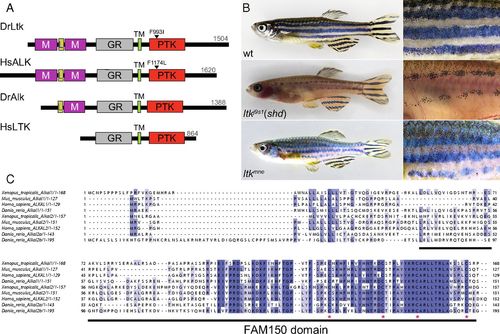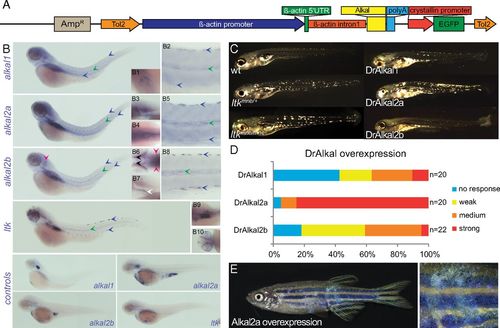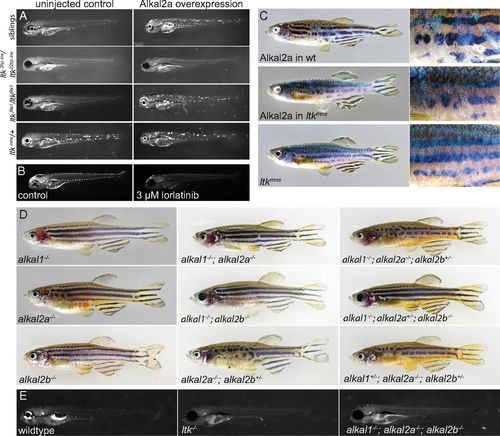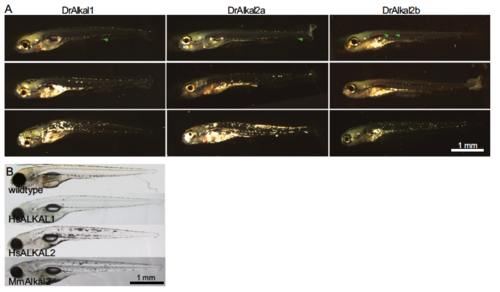- Title
-
ALKALs are in vivo ligands for ALK family receptor tyrosine kinases in the neural crest and derived cells
- Authors
- Fadeev, A., Mendoza-Garcia, P., Irion, U., Guan, J., Pfeifer, K., Wiessner, S., Serluca, F., Singh, A.P., Nüsslein-Volhard, C., Palmer, R.H.
- Source
- Full text @ Proc. Natl. Acad. Sci. USA
|
Ectopic expression of ALKALs and overactivation of DrLtk leads to supernumerary iridophores in D. rerio. (A) Domain structure of the human and zebrafish ALK/LTK RTK family. GR, glycine rich; L, LDLa; M, MAM; PTK, kinase domain; TM, transmembrane domain. The activating F993I (DrLtk) and F1174L (HsALK) mutations within the kinase domain are indicated. (B) ltk loss-of-function shady mutants (ltkj9s1) lack iridophores, while gain-of-function moonstone (ltkmne) exhibit increased numbers of iridophores. (C) Alignment of ALKAL proteins from different species. Underlined, the FAM150 domain; red asterisks, conserved Cys. Note high conservation of the C-terminal half of the FAM150 domain. PHENOTYPE:
|
|
Expression of DrAlkals is sufficient for ectopic production of iridophores. (A) Schematic of ALKAL-expression constructs. AmpR, ampicillin resistance; Tol2, medaka Tol2 transposase recognition sequence. (B) alkal expression in 72 hpf albino larvae. Weak alkal1 signal can be observed in the head, swim bladder (B1), notochord (B2; green arrowheads), and iridophores in dorsal and ventral stripes (B2; blue arrowheads). alkal2a mRNA is detected in the head (B3), swim bladder (B4), notochord (B5; green arrowheads), and iridophore stripes (B5; blue arrowheads). alkal2b mRNA is detected in swim bladder, a row of cells at the ventral aspect of the head (B7; white arrowhead), bilateral clusters in the head (B6; red arrowheads), behind the eyes (B6; black arrowheads), notochord (B8; green arrowheads), and iridophore stripes (B8; blue arrowheads). ltk expression is visible in swim bladder (B9), eyes (B10), notochord (green arrowheads), and iridophores (blue arrowheads). Negative controls, corresponding sense probes. (C) Supernumerary iridophores were observed in 5 dpf larvae upon ectopic expression of indicated DrAlkals in F0-injected fish. ltkmne larvae are used as positive controls. (D) Distribution of phenotypes of C. Fisher exact probability test showed significant differences (P < 0.001) in phenotype distribution in the following comparisons: any Alkal overexpressing fish against uninjected control and Akal2a overexpressing fish against Alkal1 or Alkal2b overexpressing fish. No significant difference was found between Alkal1 and Alkal2b overexpressing fish (P = 0.2). (E) Mosaic overexpression of alkal2a produces patches of supernumerary iridophores in adults. EXPRESSION / LABELING:
|
|
DrAlkals affect iridophore development via DrLtk. (A) Ectopic expression of DrAlkal2a does not rescue loss of iridophores in 4 dpf transheterozygous ltk knockout zebrafish larvae (2 bp insertion/22 bp insertion, n = 9/9), whereas in heterozygous or wild-type siblings and ltkj9s1 larvae, it leads to overproduction of iridophores (n = 29/29 and 34/35). Overexpression of DrAlkal2a in ltkmne mutant slightly enhances the phenotype. (B) Treatment with lorlatinib results in diminished iridophore numbers in 4 dpf larvae. (C) Mosaic overexpression of DrAlkal2a produces patches of supernumerary iridophores in wild-type and ltkmne adults. Overexpression of DrAlkal2a in ltkmne mutants enhances production of supernumerary iridophores compared with uninjected ltkmne. (D) Zebrafish alkal mutants display defects in iridophore development. alkal1ko mutants have reduced iridophores in eyes and operculum, and removal of both alkal1and alkal2b results in a complete loss of eye iridophores. alkal2ako mutants show the strongest phenotype, with reduced numbers of iridophores in the trunk, especially anteriorly. This phenotype displays increased penetrance in alkal2a;alkal2b double mutants. (E) Triple mutant for all alkal genes is embryonic lethal and displays total loss of iridophores, similar to ltk transheterozygous knockout. PHENOTYPE:
|
|
Ectopic iridophores in 5 dpf zebrafish larvae. Ectopic iridophores observed in 5 dpf larvae injected with constructs driving expression of zebrafish Alkals (A) or human and mouse ALKALs (B). Shown are examples of weak, medium, and strong phenotypes, as used in Fig. 1. Green arrowheads mark ectopic iridophores in larvae exhibiting weak phenotypes. |




